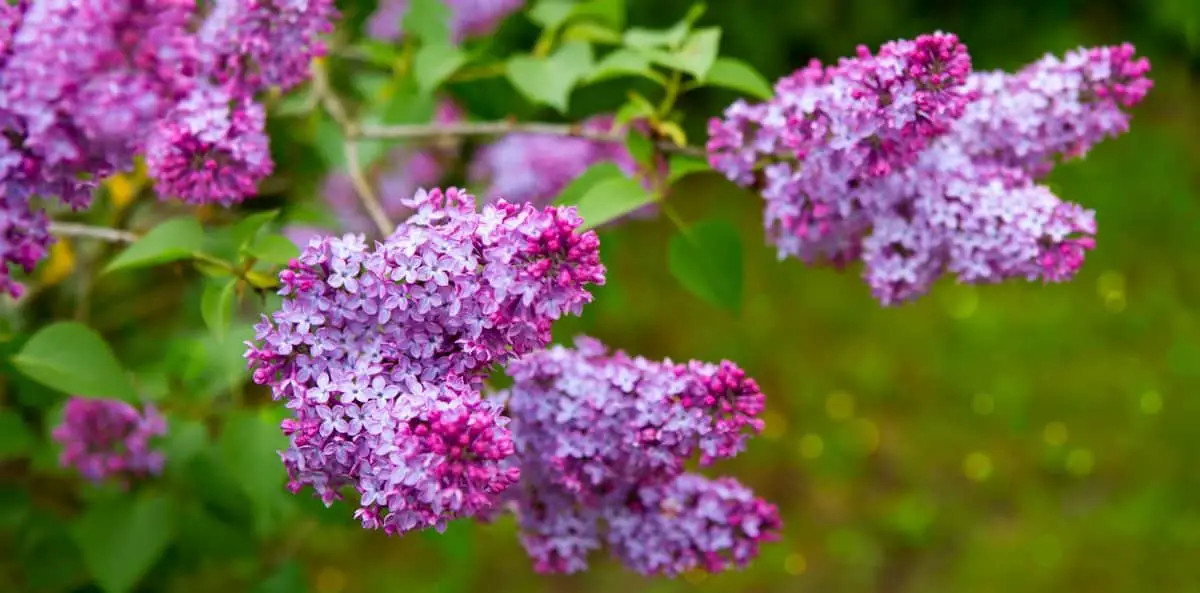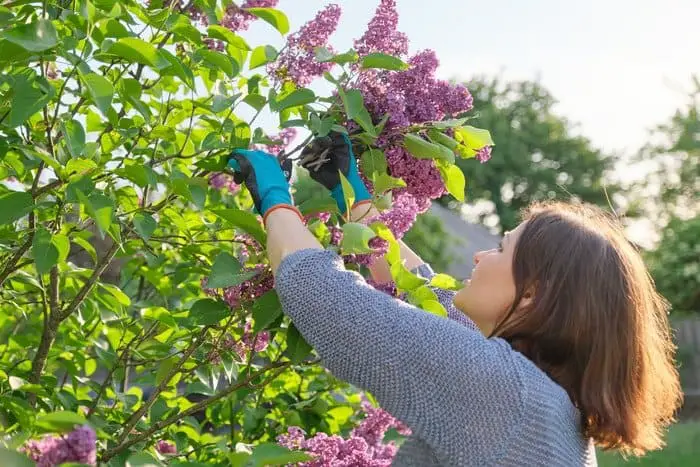Last Updated on December 28, 2021 by
Do you know how to grow lilacs from cuttings? Lilacs are beautiful plants with brilliant purple flowers that bloom in spring. They love climates of chilly winters. They also emit sweet smelling fragrances when they bloom in springtime.
The sad part of this good offering is that they only have two awesome weeks to give out their blossoms. This shortened blooming which is quite unfortunate haven’t discouraged their propagation one bit by homeowners and gardeners. They would rather prefer to enjoy the offer while it lasts. Learning how to grow lilac from cuttings can be very tricky if you are a newbie to the entire idea, but if you can keep up with the practice, you will arrive at a point where everything looks pretty seamless. But it’s going to be tough at first, that’s a given. You need patience, understanding, and consistency to achieve it.
In the succeeding texts, you’ll be learning how to grow lilac from cuttings as well as other handy tips you need to arm yourself with so you can successfully grow and enjoy a lilac plant around your home.
If you are ready, then let’s begin
The Materials you Will Need to Get this Done
Some of the material you will be needing to carry out this kind of planting include:
- Peat pots, if you are going to be growing a small bush of lilacs
- Sand or perlite
- Pruning shears (don’t forget to sterilize them)
- Rooting hormone
- Spray bottle
- Watering can
- Gardening gloves
Getting the Timing Right
Times and seasons matter a lot when it comes to growing plants. They play a major role in rooting the seeds to germination and down to harvest. In this case, we are talking about flowering plants and so they play a major from when the cutting immersed into the soil till when they begin to bloom.
Some plants are darlings to certain seasons and enemies to other seasons. If you can get the timing right, you must have scaled through your very first hurdle of propagating a lilac from its cuttings. So how do you get to go about this? Well, spring is the right time for getting the cuttings.
How to Grow Lilacs from Cuttings
Take your lilac cuttings on a fine spring morning when the temperature of the climate is low and the plant has just finished flowering. Remember to use a sterilized pruning shear or knife to do the cutting. This is necessary to avoid infesting the plant with diseases coming from an unsterilized shear and you should also use gloves when doing this.
It should be noted that if you delay in getting the cuttings during this important period, you risk getting the right results. Ensure the new growth is up to 4 to 6-inch in length before cutting. Remove the bottom leaves from cuttings while allowing two to three leaves to remain at the top.
Hosting the Plant in a Pot Soil
The cutting needs soil to host its growth. To achieve this, get a peat pot and fill it up with potting soil. Let the soil mixture be made up of sand, soil, and perlite. Water it mildly and create a hole where you can plant the cutting. You can use a stick or one of your fingers to create this planting hole.
When you’ve done this, get a rooting hormone to stimulate root growth and dip the bottom of the cutting into it before inserting it into the hole. Dress the soil mixture around the cutting, it was immersed in a small hole, you need to cover up some of the spaces by beating the soil gently with your palms, this will enable the plant stand upright and have a good balance on the soil. Also, note that you can plant more than one cutting in the potting mixture. You can plant as much as 3 to 4 cuttings provided the leaves are overlapping.
Water Continuously and Observe
You need to water the cuttings daily while you observe them in the process for noticeable growth changes. Never get the potting mixture extremely saturated or drenched in moisture.
Observe the Cutting for Rooting
A while after planting, you can go experimental to ascertain if the plant is deeply rooted downwards. You can actually tell if it has taken strong root beneath by the luxurious appearance of its leaves and the new growth. But to be sheer certain while having in mind how tricky plants can be with pointers, you can do the experimental method by pulling the cutting out of the soil. If it comes out without resistance of any sort, then you know the root is still shallow, perhaps your rooting hormone is not doing well or the plant is having challenges. But if you struggle to pull it out meeting some resistances in the process, then you know the root is really strong.
Taking Care of the Lilac Cutting
As you stay consistent with the watering, cover the pot with a transparent and neat plastic bag. This is to create a humid environment around it. But you need to once in a while open the bag to allow for sufficient air circulation. You can make it easy by creating little holes in the plastic material so you don’t need to occasionally take off the plastic covering. Failure to do this could make the root system rot and wither away.
After a month or two by then, the roots would have established their strength downwards, you can expose the plant to brilliant and indirect sunshine. This will among other things, make the potting mixture that has been receiving daily watering have the time to dry a little in between the watering.
Transplanting the Cutting
The plant won’t have to stay in its pot confines forever. When you’ve noticed that the roots have matured and can withstand a couple of unfriendly environmental challenges, you can take it out of its pot soil and into a real soil outdoors. Plant it into the soil at least 1 inch deep and provide it with moisture as soon as possible.
If you have regular rainfall in your area, you might be observing some breaks in watering but if you come from a zone that has a California kind of hot climate, then you need to water regularly, wetting the soil with about an inch of water weekly.
FAQs
How long do lilac cuttings take to root?
Lilac cuttings take around three weeks to root. You can also speed up the process by placing the cuttings in a shallow dish of water and providing them with artificial light.
Lilacs are short-lived shrubs that bloom all summer long. They are popular because they require very little care and can survive in non-ideal soil conditions.
Will lilacs regrow after cutting?
Lilacs are one of the first spring-flowering plants that come to mind when you think of this season. Although these flowers will grow back after a cutting, sometimes their roots need help in order to grow back. One way to help root growth is by using dibble sticks (a long thin stick with an indentation at one end). Lilac cuttings are easy to take and can be placed anywhere in your yard or garden bed.
Can I cut back lilacs after blooming?
Lilacs are typically cut back after blooming, but it is not always necessary. They can be left in the garden and will still provide beauty and fragrance.
It is important to make sure that they are well-watered and they have a good chance of growth because the cuttings take more time to establish roots than their healthy counterparts.
How fast do lilac cuttings grow?
Lilacs are one of the most popular flowering shrubs in the UK. They are often used to decorate homes and bring cheer. Since they tend to grow fast, flowering lilacs can cover a large area very quickly.
We found out that lilac cuttings grow at around 0.7cm per day and it takes around 6-8 weeks for them to reach their final height and size.
Lilac cuttings can be started from existing plants or from seedlings in a pot. They need to be planted into an area with good drainage though, as they will rot soon if water gets into the ground too quickly or if there is not enough space for roots to take in water.
Will lilac cuttings root in water?
Some plants will root in water, while others will not. Lilac is a plant that can root in water, and the following are some of the factors that affect this. Lilacs are native to North America and can tolerate most soils, but they need moist soil to nurture their roots and should be planted in well-drained soil. With these factors taken into consideration, you'll be able to determine if lilacs will root in water or not.
Can you root a lilac branch?
Lilacs are an ornamental plant that come in a variety of colors, including purple and white. Lilacs are typically propagated from cuttings.
A lilac's root begins life as a tiny bud, which develops into a small internode. This is the first step towards rooting the lilac flower.
The second step is to curl one of the branches around itself, creating a loop of bark and creating another bud at its base. The third step is to create another loop with the same branch and have it lay across this newly created loop. This will create two buds on either side of the most recent bud created during step two.
The fourth step is to divide these two new buds by cutting through them with your thumbnail or nail and removing their tiny shoots.
How do you start a lilac tree?
To start a lilac tree, you will need some bare soil in a large pot, which can be placed outdoors or indoors. Lilacs can be grown on the ground or in containers. In cold climates, they should be kept indoors until they start to flower and then planted outside or moved back into the house when temperatures return to normal.
Tony Manhart is a passionate gardener who has been tending to gardens for over 20 years. He takes pride in creating beautiful outdoor spaces with plants, trees, and shrubs that can thrive in any environment. He loves to share his knowledge with others and has taught classes on gardening basics and advanced techniques. He is committed to sustainability, using natural and organic methods to create and maintain gardens. He also works with local organizations to create green spaces for communities. When he’s not gardening, Tony enjoys hiking, reading, and spending time with his family.



